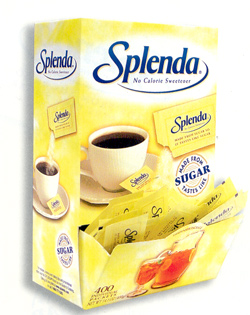
"SUCRALOSE (aka Splenda) is 600 times as sweet as table sugar. It has overtaken Equal as the most popular artificial sweetener.
- It was discovered in 1976. Put simply, it is made by chlorinating sugar! Yes, it's manufacture involves the same chemical found in swimming pools. How could this be? It was discovered through a misunderstanding. Two Tate & Lyle scientists were looking for a way to test chlorinated sugars as chemical intermediates when there was a gross misunderstanding. Leslie Hough asked his young Indian colleague Shashikant Phadnis to test the powder. Phadnis thought Hough said "taste," and he did--it was very sweet! A final sweetener formula was developed within a year.
- Sucralose is composed of 50 percent phenylalaline, 40 percent aspartic acid, and 10 percent methyl alcohol.
- Sucralose mixed with maltodextrin and dextrose (both made from corn) as bulking agents is sold internationally as Splenda.
- In 1998 it was approved by the U.S. FDA; as of 2006 it has been approved in more than sixty countries.
- In 2000 concerns over safety surfaced, including lack of long-term studies.
- Whole Foods Market took an official stand that it will not carry any products containing sucralose because, as the company points out, most of the studies were commissioned by organizations that had a financial interest in the approval of sucralose.
- Reported symptoms of sensitivity to this compound include headaches, dizziness/balance problems, mood swings, vomiting and nausea, abdominal pain and cramps, seizures and convulsions, and changes in vision. Concerns have also been raised regarding its effect on the thymus gland, crucial to proper immune system functioning.
- Sucralose can be found in more than 4,500 food and beverage products.
- Marketed in the United States as a "no-calorie sweetener," Splenda does contain 96 calories a cup, approximately eight times fewer than sugar by volume."
No comments:
Post a Comment